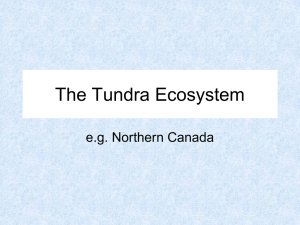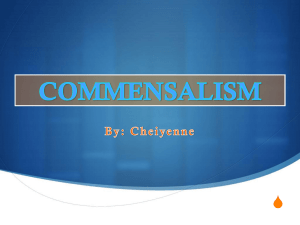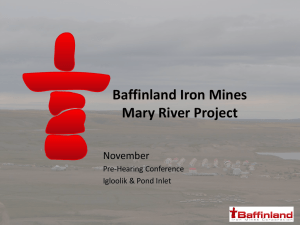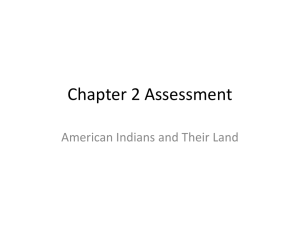BOREAL CARIBOU COMMITTEE
advertisement
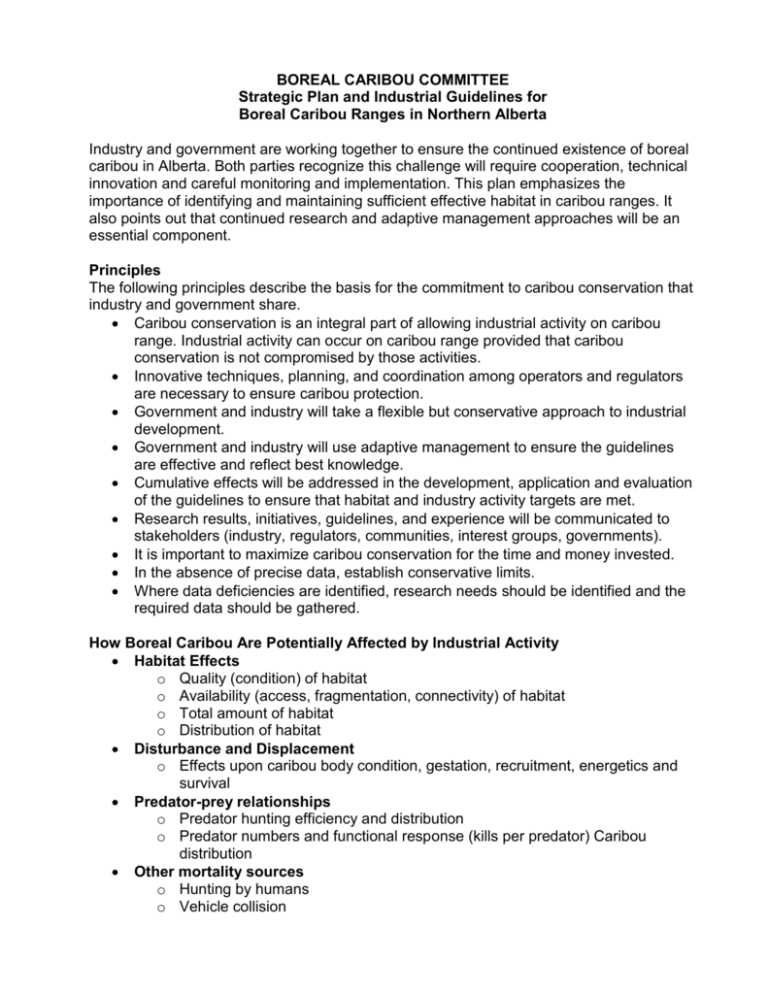
BOREAL CARIBOU COMMITTEE Strategic Plan and Industrial Guidelines for Boreal Caribou Ranges in Northern Alberta Industry and government are working together to ensure the continued existence of boreal caribou in Alberta. Both parties recognize this challenge will require cooperation, technical innovation and careful monitoring and implementation. This plan emphasizes the importance of identifying and maintaining sufficient effective habitat in caribou ranges. It also points out that continued research and adaptive management approaches will be an essential component. Principles The following principles describe the basis for the commitment to caribou conservation that industry and government share. Caribou conservation is an integral part of allowing industrial activity on caribou range. Industrial activity can occur on caribou range provided that caribou conservation is not compromised by those activities. Innovative techniques, planning, and coordination among operators and regulators are necessary to ensure caribou protection. Government and industry will take a flexible but conservative approach to industrial development. Government and industry will use adaptive management to ensure the guidelines are effective and reflect best knowledge. Cumulative effects will be addressed in the development, application and evaluation of the guidelines to ensure that habitat and industry activity targets are met. Research results, initiatives, guidelines, and experience will be communicated to stakeholders (industry, regulators, communities, interest groups, governments). It is important to maximize caribou conservation for the time and money invested. In the absence of precise data, establish conservative limits. Where data deficiencies are identified, research needs should be identified and the required data should be gathered. How Boreal Caribou Are Potentially Affected by Industrial Activity Habitat Effects o Quality (condition) of habitat o Availability (access, fragmentation, connectivity) of habitat o Total amount of habitat o Distribution of habitat Disturbance and Displacement o Effects upon caribou body condition, gestation, recruitment, energetics and survival Predator-prey relationships o Predator hunting efficiency and distribution o Predator numbers and functional response (kills per predator) Caribou distribution Other mortality sources o Hunting by humans o Vehicle collision OVERALL STRATEGY The primary focus of this caribou protection strategy is the maintenance of sufficient effective habitat in caribou ranges. The strategy also describes the need to ensure that caribou are protected against excessive industrial activity in a range in any given year. Overall Concept for Boreal Caribou Industrial Guidelines (May 2001) STRATEGIC PLAN o Describes common understanding, the Habitat and Activity Targets, and Best Practices. RANGE PLAN o Defines range specific guidelines and strategies to meet the Habitat Target in consideration of existing and projected industrial and fire disturbance. o An inventory of industrial activity and forest fires maintained in a central GIS system will be updated annually. CARIBOU PROTECTION PLANS o Operators annually describe operations in caribou ranges, including specific means to protect caribou in accordance with range plan (submitted by October 15 of each year). Industry Activity Target (Excessive Disturbance) Extremely high levels of industrial activity have the potential to reduce caribou survival and/or reproductive success. Recognizing this, a target for the maximum amount of disturbance allowed within caribou ranges at a given time will be developed. In specific (and likely infrequent) situations where the target is exceeded, steps will be taken to prevent excessive disturbance. Government, in collaboration with industry, will develop a formula to quantify proposed industrial activity for a given season, within each caribou range. The extent, duration and intensity of activity will be evaluated. This formula will enable a consistent and transparent evaluation to take place across all ranges. Professional judgment and past research findings (including research outside of Alberta) will be used to identify the target for maximum allowable disturbance levels. In October or November, following the annual submission of Caribou Protection Plans, government and industry will work together to identify areas of concern (ranges or portions of ranges) and ensure that disturbance levels remain below identified target. CARIBOU PROTECTION PLANS Caribou Protection Plans (CPPs) describe the industrial activities that companies are proposing within caribou ranges in the coming year. They are a critical basis for the collaborative effort between government and industry to protect caribou by managing overall changes to habitat and overall disturbance levels. CPPs become an integral part of any authority via an administrative condition placed on that authority. Submission Companies are required to submit CPPs for any projects in caribou ranges or new projects requiring access through caribou range. Plans for each winter’s work must be submitted by October 15, with amendments accepted until November 30. There is no submission deadline for CPPs or amendments relating to summer work. Government will review and respond to CPPs within two weeks. CPPs are submitted in order to: Allow the provincial government to predict the level of activity and habitat disturbance in each caribou range. Document the company’s commitment to work within the land use strategy and to meet the requirements of the relevant caribou range plan, once range plans are developed. Standard Requirements CPPs must include: A description of the work to be undertaken, identifying locations and extent of work; A description of the land area that will be affected by the work; A detailed description of caribou conservation measures which illustrates the company’s commitment to adhere to best practices (and range plan requirements, as soon as they are available); A proposed schedule for the work; and A map showing the location of all work to be completed (map will be digital once standards are developed). Unforeseen Additional Activities Allowances may be made for unforeseen projects, independent of an existing approved CPP. Requests will be considered, in the context of factors such as size of project, time of year, other work in the area, and activity target, provided the company submits a rationale for the request, a detailed description of the project requirements and a mitigation plan. BEST PRACTICES FOR CARIBOU RANGES Companies and government have been working together to identify practices that reduce negative effects upon caribou while considering the implementation cost to industrial operators. The following sections of this strategy describe Best Practices for each industrial sector that will be implemented effective September 2001. To minimize cumulative disturbance, all companies working in caribou range should jointly review their plans and identify opportunities for integration and common use. Better integration between company departments, within industry sectors, and between sectors needs to occur. “Existing Activity Areas” (as identified on the current NW Boreal Wildlife Referral map) will continue to be included within identified caribou range, and “Best Practices” will apply to new industrial work. Proposed development in these areas must be addressed in a CPP. Best practices will also be used during the development of Range Plans to project the future development footprint on each range. Where it is projected that the habitat target will not be met, range specific actions that go beyond best practices will be determined. Range Plans will incorporate or modify Best Practices as operating guidelines on a range-byrange basis. Linear Disturbances There is evidence of reduced use by caribou of areas adjacent to linear disturbances. These disturbances alter the pattern and rate of movement of caribou, humans and other ungulates and also improve the hunting success of predators and humans. In some cases, linear developments (such as roads and above ground pipelines) create physical barriers that affect caribou movement. The impact of a linear disturbance is reduced if the vegetation on the site is protected and/or allowed to recover quickly and there is no lasting game trail. The following characteristics describe the impact of linear disturbances: Width and Variability in Corridor Development: Greater width makes the travel corridor more obvious and accessible to predators, humans and alternate prey. Width affects regeneration time and snow condition. If vegetation is left in a pattern that does not leave a recognizable trail (e.g., meandering), and there is no duff (organic layer) disturbance, these issues are reduced or eliminated. Density/Length: Greater length of linear clearings creates greater potential for impact. In general, a single corridor has less potential impact than many corridors; shorter corridors have less potential impact than longer corridors. Recovery: The more time it takes for natural vegetation, especially trees and shrubs, to recover the site, the more likely that the site will be used as a trail by humans, predators and other ungulates and have a negative impact on caribou populations. Removal of the duff layer increases the potential for significant long term impact. Timing: Late winter and spring are the times of year when caribou (especially pregnant cows) are most likely to be negatively affected by human activity on linear corridors. Physical Barriers: The presence of physical barriers such as roads, above ground pipelines and snow piles may impact caribou movement. Induced Access: Opportunities for access by predators and humans follow the initial clearing of a linear corridor. If opportunities for access are reduced, there will be less impact on caribou. Effects on Hydrology: Changes to hydrology in peatlands can change habitat suitability (lichen production) for caribou. Non-linear Disturbances There are many industrial activities that alter or remove large or small blocks of habitat that support boreal woodland caribou. Since boreal caribou utilize a dispersed distribution strategy to avoid predation, the availability of large areas of habitat is important to their survival. There is evidence that the success of caribou is related to the amount of clearing within, and adjacent to, caribou range. Non-linear disturbances within, or adjacent to, caribou range may negatively affect caribou populations if the result is: Feeding areas become unfavourable or inaccessible. The areas where caribou can disperse are reduced. Sight and noise disturbances cause caribou to avoid the area. he movement and populations of predators in caribou ranges is increased, or the effectiveness with which the predators can locate and kill caribou is increased. The distribution or abundance of other ungulates (alternate prey) is changed. The following factors affect the impact that a non-linear disturbance could have on caribou populations: Amount and Pattern of Clearing: There is concern that the success of caribou herds is related to the amount of clearing within their range, and to the pattern of the clearing. Concerns include: - Direct Removal of Peatland (Lowland) Habitat - Direct Removal of Old Pine Habitat - Effects on alternate prey and predators Successional Change and Recovery: Clearing of forested land changes the successional pattern. Industrial Use of the Site: Several variables affect how much industrial use of the site will affect caribou populations. These include: - Type of use (especially use of machinery) - Frequency and pattern of use - Duration of use Induced Access and Other Use: If the site is accessible by motorized vehicle, other human users (especially hunters) may be attracted to use the site. Timing: Caribou are particularly vulnerable to disturbances during late winter and spring. FOREST INDUSTRY - NON-LINEAR DISTURBANCE A Natural Disturbance Model (NDM) provides a guide to managing stands and landscapes in a manner that will more closely approximate the natural system in which woodland caribou have evolved. Since habitat quantity and quality have been identified as key concerns for caribou conservation, timber harvesting under a NDM is a good starting point for forest companies to minimize their effect on caribou. Special planning (or “fine filter” approaches) will also be required. Forest companies can play a role in minimizing disturbance and displacement of caribou through the timing and nature of their activities. Integrated planning and coordinated operations on a single land base are essential to the success of caribou conservation strategies. The following lists Best Practices for the forest industry in relation to non-linear developments. Timing For winter work, work will commence immediately after freeze-up, with the appropriate steps taken to complete most or all of the work within caribou range in the earlier part of the winter season. Each company is expected to clearly describe how this will be accomplished in their schedule of activities. All attempts should be made to access the most remote areas and complete all activities in these areas in order to close down access and limit disturbance across large areas of caribou range throughout the late winter period. Ensure that hauling, restoration and silviculture take place in a timely fashion following the harvesting of the block. FOREST INDUSTRY - LINEAR DISTURBANCE There are two types of linear features created by the forest industry in Alberta. In-block roads provide temporary access and are reclaimed and reforested once work in the block has been completed. The second type are routes from existing roads to the cutblocks. Access roads constructed by the forest companies range from winter-access roads, to permanent all-weather roads. Due to the potential for access to negatively affect woodland caribou, it is important for forest companies to take a modified approach to access development within caribou range. The following table lists Best Practices for the forest industry relating to linear developments. Due to the variability on the landscape as well as caribou status considerations for particular ranges, application of these best practices may vary on a sitespecific basis. Timing Winter work will commence immediately after freeze-up, with appropriate steps taken to complete most or all work within caribou range in the earlier part of the winter season. The company is expected to clearly describe how this will be accomplished in their schedule of activities. All attempts should be made to access the most remote areas first and complete all activities in these areas in order to close down access and limit disturbance across large areas of caribou range throughout the late winter period. Ensure that hauling, restoration and silviculture take place in a timely fashion following the harvesting of the block. In most cases it is desirable to complete approved operations within the season, rather than reopening access the next year if no further work is planned for the following year. HORTICULTURAL PEAT HARVESTING Overall Approach To date, approximately 1,800 hectares of bog have been allocated for horticultural peat harvesting in the Green Area of Alberta. Only a small portion of this allocation falls within caribou range, and currently there is no peat activity in caribou range. The industry has projected the need for an additional 20,000 hectares of peatland in northern Alberta to supply the industry for the next 20 to 50 years. Allocation of peatlands within Alberta must be reviewed by a provincial working group comprised of industry and government and the Boreal Caribou Committee. The intent of this process will be to meet the long term needs of the peat industry primarily outside of caribou ranges. If peat harvest areas are proposed within caribou range, these activities must be consistent with the range level habitat targets. Peat harvesting is a non-linear disturbance with a typical harvest site of 500 hectares, comprised of a contiguous network of smaller peat fields. A harvest site is operational for approximately 15 to 20 years. Due to wet ground conditions, field clearing, drainage and access grade development must occur on frozen ground. Harvesting occurs during the months of April to October and peat hauling, at most sites, occurs year round. Research indicates that harvested sites can be returned to a functioning wetland relatively quickly. Restoration of a site to functioning caribou habitat is anticipated to take much longer and has been identified as a research priority. To minimize the impact of peat harvesting on caribou populations, the industry will: work with the provincial government and the Boreal Caribou Research Program (BCRP) on selection and allocation of bogs; apply the principle of “early in/early out” with development activities; and focus restoration research on recovery of caribou habitat. Timing Clearing and piling of any forest cover – commence as early as possible following freeze up and completed as early as possible. Clearing and installing outlet ditches – commence as early as possible following freeze up and completed as early as possible. Construction of road grade to/within the cleared area will be completed on frozen ground, however final contouring and graveling will be completed during the summer months. Field preparation within cleared area – year round. Hauling – year round. OIL AND GAS INDUSTRY - NON-LINEAR DISTURBANCE Non-linear disturbances include oil and gas production facilities, well sites and pads, and other supporting areas such as borrow pits, camps, communications sites, etc. These disturbances will be as small as practical. The majority of equipment and activity will be concentrated at these sites to minimize the level of habitat disruption and activity that is dispersed over the caribou range. Gas production facilities and wells will primarily be operated remotely. Oil production facilities and wells will be operated remotely if technology is available to support and make this practical. Innovative technology must be developed to improve the opportunities for remote oil operations. Reduction of the number of access routes and the frequency of access is essential for the conservation of caribou. Achievement of this critical goal will require innovation and new approaches, particularly with respect to remote operations. Development of all-weather roads should be avoided whenever there is a feasible alternative. Where roads are necessary, public access will be managed. Timing For winter work, work will commence immediately after freeze-up, with the appropriate steps taken to complete most or all of the work within caribou range in the earlier part of the winter season. The company is expected to clearly describe how this will be accomplished in their schedule of activities. OIL AND GAS INDUSTRY - LINEAR DISTURBANCE Linear disturbances include right of way (ROW) for pipelines, utilities, and access to oil and gas facilities and wells. Wells include exploration wells (coreholes or strat wells), production wells and utility wells. Efforts will be made to reduce the number of linear disturbances though the use of common corridors. Non-disturbance of the duff layer (ground cover and organic layer of soil), where possible, will encourage early recovery of the ROW. Development of all-weather roads should be avoided whenever there is a feasible alternative. Where roads are necessary, public access will be managed. Timing For winter work, work will commence immediately after freeze-up, with the appropriate steps taken to complete most or all of the work within caribou range in the earlier part of the winter season. The company is expected to clearly describe how this will be accomplished in their schedule of activities. SEISMIC ACQUISITION - LINEAR DISTURBANCE Due to the extensive nature of seismic activities they are a dominant feature in the existing industrial footprint on the landscape. Changes to seismic line cutting practices and remediation which reduce the initial impact and longevity of lines will significantly reduce cumulative effects. Rapid recovery of vegetation is an important consideration. Timing No operations during caribou calving (April 15 to June 1). For winter work, work will commence immediately after freeze-up, with the appropriate steps taken to complete most or all of the work within caribou range in the earlier part of the winter season. The company is expected to clearly describe how this will be accomplished in their schedule of activities.

